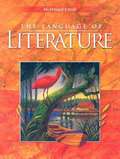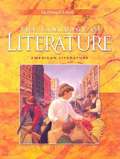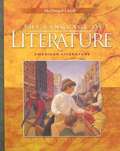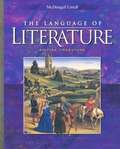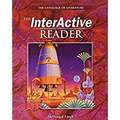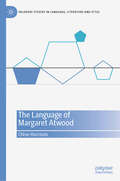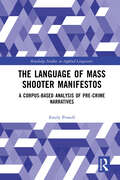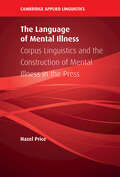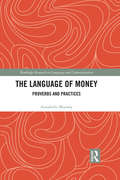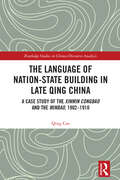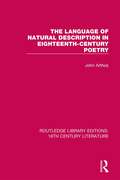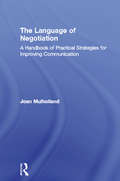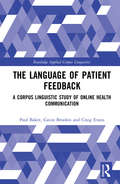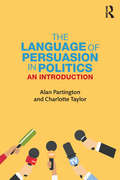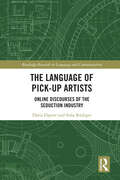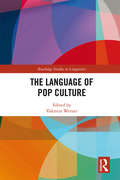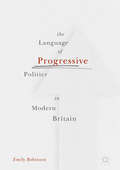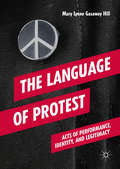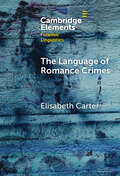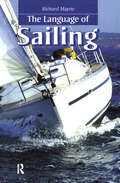- Table View
- List View
The Language of Literature (Grade #9)
by Arthur N. Applebee Sheridan Blau Andrea B. Bermudez Rebekah CaplanLiterature textbook for 9th graders.
The Language of Literature: American Literature
by Arthur N. Applebee Sheridan Blau Andrea B. Bermudez Rebekah CaplanLiterature textbook focusing on American literature.
The Language of Literature: American Literature
by James Marshall Arthur N. Applebee Judith A. Langer Sheridan Blau Andrea B. Bermudez Peter Elbow Susan Hynds Rebekah GaplanAs in each of the books in the Literature Connections series this text comprises a novel or play with related readings--poems, stories, plays, personal essays, articles--that add new perspectives on the theme or subject matter of the longer work.
The Language of Literature: American Literature (11th Grade)
by James Marshall Arthur N. Applebee Judith A. Langer Sheridan Blau Andrea B. Bermudez Rebekah Caplan Peter Elbow Susan HyndsA literature book that combines novels or plays with related readings--poems, stories, plays, personal essays, articles--that add new perspectives on a theme or subject matter of the long work.
The Language of Literature: British Literature
by James Marshall Arthur N. Applebee Judith A. Langer Sheridan Blau Andrea B. Bermudez Rebekah Caplan Peter Elbow Susan HyndsThis book combines a novel or play with related readings--poems, stories, plays, personal essays, articles--that add new perspectives on the theme or subject matter of the longer work.
The Language of Literature: British Literature
by James Marshall Arthur N. Applebee Judith A. Langer Sheridan Blau Andrea B. Bermudez Rebekah Caplan Peter Elbow Susan Hynds Franchelle DornThe Language of Literature (British Literature) contains classical resources of reading materials which include plays, novels, fiction, nonfiction, poetry, etc.
The Language of Literature: British Literature
by James Marshall Arthur N. Applebee Judith A. Langer Sheridan Blau Rebekah Caplan Peter Elbow Susan Hynds Andrea B. BerrnúdezTextbook on British literature.
The Language of Literature: The InterActive Reader (Grade 7)
by McDougal LittellThe InterActive Reader is a new kind of literature book. As you will see, this book helps you become an active reader.
The Language of Margaret Atwood (Palgrave Studies in Language, Literature and Style)
by Chloe HarrisonThis book explores Margaret Atwood’s distinctive use of language and style, across a selection of her prose texts, through reader-centred, cognitive stylistic analyses. It examines how strategies of misdirection, processes of doubling, and the creation of textual ambience play an essential role in Atwood’s contemporary prose fiction style. With reference to contemporary scholarship in stylistics and literary criticism, each chapter presents a detailed linguistic analysis of a different text from Atwood’s oeuvre, from Alias Grace (1996) to Old Babes in the Wood (2023). Above all, the book studies experiences of reading Atwood’s works, situating and contextualising her signature linguistic choices in relation to real readers’ responses to her writing. The book should be of interest to readers specialising in the work of Margaret Atwood, including those with stylistics, cognitive linguistics, and literary studies backgrounds.
The Language of Mass Shooter Manifestos: A Corpus-Based Analysis of Pre-Crime Narratives (Routledge Studies in Applied Linguistics)
by Emily PowellBringing together scholarship from corpus linguistics, forensic linguistics, and criminology, this book offers a nuanced exploration of moral agency in the pre-crime narratives of offenders.The volume seeks to complement existing literature in forensic linguistics, which often explore criminal narratives elicited after the crime with the benefit of hindsight, by examining texts written in the midst of events. Analyses draw on a corpus of over 200,000 words of manifestos and diaries written by four ‘lone attackers’ who perpetrated mass shootings, and put together accounts of their lives and the preparation for their crimes. Incorporating stylistic approaches to non-fiction texts with those from corpus linguistics, Powell explores the ways in which these texts influence perpetrators and future offenders and, more broadly, the role of narrative as it relates to harmful actions. A closing section includes a taxonomy of moral agency which may serve as the foundation for future research on understanding agency, responsibility, and offending from a linguistic perspective.This book will be of interest to scholars in forensic linguistics, corpus linguistics, stylistics, and criminology.
The Language of Mental Illness: Corpus Linguistics and the Construction of Mental Illness in the Press (Cambridge Applied Linguistics)
by Hazel PriceMental health is a matter of vital importance in today's society, with the news media reporting on the topic on an almost daily basis. Despite this, the language associated with mental health has to date been relatively under-explored. Using methods from corpus linguistics and critical discourse analysis, this pioneering book is the first large-scale linguistic investigation of UK news reports on mental illness. Based on a purpose-built corpus of 45 million words of UK press reports on mental illness, it offers a range of analyses exploring language development across time, in addition to focusing on the differences between press representations of specific mental illnesses. The book provides linguistic insights into public perceptions of mental illness, as well as stigma creation and perpetuation in the media. It also includes original and significant methodological innovations, making it a vital resource for researchers for in corpus linguistics, health communication, and the health humanities.
The Language of Money: Proverbs and Practices (Routledge Research in Language and Communication)
by Annabelle MooneyThrough a detailed examination of proverbs related to money, this book offers a comprehensive critique of the prevailing everyday ideologies and discourses on money and paves the way toward establishing a new set of proverbs more conducive to financial equality and human well-being. The volume explores a variety of contexts to demonstrate the different aspects of the money system and the linguistic and social structures embedded within them, including pay day loan websites, gambling, get rich self-help books, and new forms of currency. Unpacking this complex relationship between people, money, and language in contemporary society, this book is an ideal resource for students and scholars in language and communication, sociolinguistics, rhetoric, sociology, and media studies.
The Language of Nation-State Building in Late Qing China: A Case Study of the Xinmin Congbao and the Minbao, 1902-1910 (Routledge Studies in Chinese Discourse Analysis)
by Qing CaoThe Language of Nation-State Building in Late Qing China investigates the linguistic and intellectual roots of China’s modern transformation by presenting a systematic study of the interplay between language innovation and socio-political upheavals in the final decade of the Qing Dynasty. This book examines the formations, internal tensions, and promotion of such macroconcepts as ‘nation people’ (guomin国民), nation (minzu民族), society (qun群), state (guojia国家) and revolution (gemin革命) as novel ideas borrowed from Europe but mediated through Meiji Japan. Using corpus-based discourse analysis of the full-text corpus (4.2 million words) of the two most influential periodicals Xinmin Congbao (新民丛报) and Minbao (民报), this book scrutinises the multi-faceted formulations of these concepts and their impact. It underscores the adaptation and appropriation of European post-enlightenment values to the socio-political conditions of late Qing society. The analysis centres on the epic debate (1905-07) between these two periodicals that offered two distinctive visions of future China. Comparable to the 18th century great debate between Edmund Burke and Thomas Paine on the French Revolution, the Chinese debate has hitherto attracted little scholarly attention outside China. Yet, the debate not only turned the tidal wave of the public opinion against the Manchu monarchy and contributed to its downfall in 1911; it has given rise to a radical current of intellectual thinking whose ramifications have been keenly felt throughout 20th century China. This book represents the first study in English on this press debate that contributes significantly to the intellectual foundation of modern China. This book will be useful and relevant to academics, postgraduate students and final year undergraduate students in the field of Chinese Studies, and anyone interested in the role of language in shaping modern intellectual history.
The Language of Natural Description in Eighteenth-Century Poetry (Routledge Library Editions: 18th Century Literature)
by John ArthosOriginally published in 1949, this title was written in order to help establish a better understanding of the ‘stock diction’ of eighteenth-century English poetry, and, in particular, of the diction commonly used in the description of nature. The language characteristic of so much of the poetry of this period had been severely criticized for a long time. But in the twenty or thirty years prior to publication some effort had been made to review the subject and the problem. However, several questions still remained unanswered, and more exhaustive analysis needed to be undertaken. This volume was an effort to provide answers for some of these questions and to begin the analysis that was required.
The Language of Negotiation: A Handbook of Practical Strategies for Improving Communication
by Joan MulhollandThe Language of Negotiation aims to heighten awareness of language and to suggest practical ways to use language-related tactics to get results. It encourages the reader to recognise negotiation as a specifically language-centred activity and demonstrates how learning to use language effectively can radically improve negotiation skills. The book features: A step-by-step guide on the practice of negotiation, from preparation to follow-up after the event Chapters on various aspects of negotiation, such as the spoken, written and interpersonal sides, as well as media interviewing and using the phone. Specific and useful strategies for actions like advising, complaining, confirming and dismissing. A range of effective and informative examples throughout, designed to show the value of enhanced language use and practical exercises to encourage the reader to apply the ideas to their own practice. The Language of Negotiation will be of value to all those in business and professional life whose work involves negotiation. It will also be of particular interest to students in graduate schools of business or management and to anyone who has an interest in improving their negotiation skills. No prior knowledge of language theory is assumed on the part of the reader.
The Language of New Media Design: Theory and Practice
by Radan Martinec Theo van LeeuwenThe Language of New Media Design is an innovative new textbook presenting methods on the design and analysis of a variety of non-linear texts, from websites to CD-Roms. Integrating theory and practice, the book explores a range of models for analyzing and constructing multimedia products. For each model the authors outline the theoretical background and demonstrate usage from students' coursework, commonly available websites and other multimedia products. Assuming no prior knowledge, the book adopts an accessible approach to the subject which has been trialled and tested on MA students at the London College of Communication. Written by experienced authors, this textbook will be an invaluable resource for students and teachers of new media design, information technology, linguistics and semiotics.
The Language of Organizational Styling
by Lionel WeeThe ways in which commercial organizations and service providers 'style' themselves - creating the image they wish to portray to their potential consumers - is a long-established area of research in the fields of sociology and business studies. However language also plays an important role in organizational styling, something which until now has been largely overlooked in the literature. This is the first book-length study of the linguistics of organizational styling, looking at the language and semiotic resources used by holiday resorts, pharmaceutical companies, restaurants and insurance companies in order to project their identities, and style themselves. It discusses in detail a number of case studies and presents an innovative take on the notion of style, as well as bringing together work from linguistics, business studies and sociology. This interdisciplinary book will be of interest to scholars and advanced students in sociolinguistics, and scholars of sociology and business studies.
The Language of Patient Feedback: A Corpus Linguistic Study of Online Health Communication (Routledge Applied Corpus Linguistics)
by Paul Baker Craig Evans Gavin BrookesThe Language of Patient Feedback provides a unique insight into a diverse range of issues related to healthcare. Through the comprehensive and detailed interrogation of 29 million words of online patient feedback on the NHS in England, as well as 11 million words of responses to the feedback from NHS providers, this book: Uses a combination of computer-assisted and human analysis (Corpus-Assisted Discourse Analysis) to examine the extent to which characteristics like age and gender result in different types of evaluation. Investigates why nurses, doctors, dentists and receptionists are associated with very distinct types of feedback. Demonstrates the ways that NHS staff respond to comments and what this reveals about underlying institutional ideologies and practices. Concludes with suggestions for key recommendations that the NHS could act upon to improve the overall level of care it provides, as well as reflecting on what patient evaluation can actually tell us. The Language of Patient Feedback is key reading for anyone undertaking research within corpus linguistics, discourse analysis and health communication.
The Language of Persuasion in Politics: An Introduction
by Charlotte Taylor Alan PartingtonThis accessible introductory textbook looks at the modern relationship between politicians, the press and the public through the language they employ, with extensive coverage of key topics including: ‘spin’, ‘spin control’ and ‘image’ politics models of persuasion: authority, contrast, association pseudo-logical and ‘post-truth’ arguments political interviewing: difficult questions, difficult answers metaphors and metonymy rhetorical figures humour, irony and satire Extracts from speeches, soundbites, newspapers and blogs, interviews, press conferences, election slogans, social media and satires are used to provide the reader with the tools to discover the beliefs, character and hidden strategies of the would-be persuader, as well as the counter-strategies of their targets. This book demonstrates how the study of language use can help us appreciate, exploit and protect ourselves from the art of persuasion. With a wide variety of practical examples on both recent issues and historically significant ones, every topic is complemented with guiding tasks, queries and exercises with keys and commentaries at the end of each unit. This is the ideal textbook for all introductory courses on language and politics, media language, rhetoric and persuasion, discourse studies and related areas.
The Language of Pick-Up Artists: Online Discourses of the Seduction Industry (Routledge Research in Language and Communication)
by Daria Dayter Sofia RüdigerThis book adopts a corpus-based discourse analysis approach to the study of the communicative practices of pick-up artists, offering a systematic exploration of distinct language use in an online community that uses speed-seduction practices for short-term dating and sex. Drawing on a multi-million-word corpus comprising data from online forums, social media, informational websites, and YouTube videos, the volume explores the verbal practices and narrative framing techniques that pick-up artists (PUAs) draw upon in their interactions with women and the terminology-heavy language used in teaching pick-up to foster perceptions of scientific validity. The book also unpacks videos and reports of live interactions to study naturally occurring PUA discourse from different perspectives but also to more closely examine conceptual metaphors of competition and violence and critically reflect on the ethical considerations of working with such communities. This book will appeal to students and scholars in such disciplines as discourse analysis, corpus linguistics, computer-mediated communication, and language and media, as well as those interested in the study of language use online.
The Language of Pop Culture (Routledge Studies in Linguistics)
by Valentin WernerThis collection brings together contributions from both leading and emerging scholars in one comprehensive volume to showcase the richness of linguistic approaches to the study of pop culture and their potential to inform linguistic theory building and analytical frameworks. The book features examples from a dynamic range of pop culture registers, including lyrics, the language of fictional TV series, comics, and musical subcultures, as a means of both providing a rigorous and robust description of these forms through the lens of linguistic study but also in outlining methodological issues involved in applying linguistic approaches. The volume also explores the didactic potential of pop culture, looking at the implementation of pop culture traditions in language learning settings. This collection offers unique insights into the interface of linguistic study and the broader paradigm of pop culture scholarship, making this an ideal resource for graduate students and researchers in applied linguistics, English language, media studies, cultural studies, and discourse analysis.
The Language of Progressive Politics in Modern Britain
by Emily RobinsonThis book traces the word 'progressive' through modern British history, from the Enlightenment to Brexit. It explores the shifting meanings of this term and the contradictory political projects to which it has been attached. It also places this political language in its cultural context, asking how it relates to ideas about progressive social development, progressive business, and progressive rock music. 'Progressive' is often associated with a centre-left political tradition, but this book shows that this was only ever one use of the term - and one that was heavily contested even from its inception. The power of the term 'progressive' is that it appears to anticipate the future. This can be politically and culturally valuable, but it is also dangerous. The suggestion that there is only one way forward has led to fear and doubt, anger and apathy, even amongst those who would like to consider themselves 'progressive people'.
The Language of Protest: Acts Of Performance, Identity, And Legitimacy
by Mary Lynne Gasaway HillRooted in the performative of Speech Act Theory, this interdisciplinary study crafts a new model to compare the work we do with words when we protest: across genres, from different geographies and languages. Rich with illustrative examples from Turkey, U.S., West Germany, Romania, Guatemala, Great Britain, and Northern Ireland, it examines the language of protest (chants, songs, poetry and prose) with an innovative use of analytical tools that will advance current theory. Operating at the intersection of linguistic pragmatics and critical discourse analysis this book provides fresh insights on interdisciplinary topics including power, identity, legitimacy and the Social Contract. In doing so it will appeal to students and scholars of sociolinguistics, pragmatics and critical discourse analysis, in addition to researchers working in sociology, political science, discourse, cultural and communication studies.
The Language of Romance Crimes: Interactions of Love, Money, and Threat (Elements in Forensic Linguistics)
by Elisabeth CarterExploring the interplay of love, money and threat in romance fraud, this Element reveals how language is used to persuade, manipulate, and threaten without causing alarm. It provides the first empirical examination of criminal interactions-in-action that exposes and tracks the grooming process and manipulation techniques from first contact with the fraudster, to the transition between romance and finance, and requests for money and intimate images, before morphing into explicit threats and acts of sextortion. Through the use of a range of interactional methodologies and real romance fraud messages, a new type of criminality in the form of 'romance fraud enabled sextortion' is revealed. The insights contained in this work have clear implications for future directions of academic exploration and practitioner efforts to protect the public. This title is also available as Open Access on Cambridge Core.
The Language of Sailing
by Richard MayneThere have been many dictionaries explaining to laymen the technical terms of sailing. None of them, until now, has systematically set out to explore their etymology and evolution. The Language of Sailing demonstrates that many of the American and British words in question are derived-- often in complex and controversial ways--from other languages, mainly European. The diction of the sea, in fact, is a huge and hybrid skein, much of it traceable as far back as Sanskrit. It reveals that seafaring knitted Europeans together, sometimes in conflict and rivalry, often also in comradeship, when sailing crews could be as multinational as today's international conglomerates. The Language of Sailing is not intended simply for the entertainment of sailors and scholars. Anyone interested in the literature of the sea will find here an unusual and suggestive resource.
